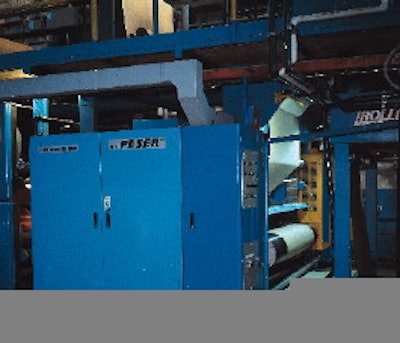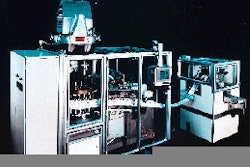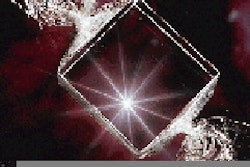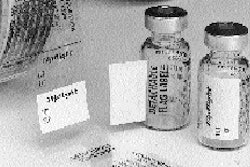With the turn of a key, Bart Gaffney unlocks a door to a showroom that contains tidy stacks of set-up corrugated and fiberboard boxes and displays. These brightly decorated containers serve as examples of what's manufactured and printed at the Milwaukee plant of Longview, WA-based Longview Fibre Co. Longview customers use these containers to market, protect and transport everything from beer and beverages to produce, toys and computer software. The beauty of these containers is much more than skin deep. In fact, the real beauty is beneath the printed surface, where the fluting is bonded to the liner. Gaffney, sales manager for the Milwaukee plant, demonstrates by handing this editor two flat pieces of unprinted single-wall corrugated board. One piece reveals lines, or marks, caused by the pressure roll that's traditionally used to bond the medium to the linerboard to produce single-face corrugated. The other piece of board is virtually free of these marks. Wiping a hand across it reveals the latter's surface is considerably smoother. Traditionally, medium and liner webs are nipped at a single point between large cylindrical pressure rolls made of steel. The pressure from these rolls on the two material webs, combined with the use of a cornstarch-based adhesive, creates the single-face board by bonding fluted medium to the liner. Trouble is, that single pressure point can take its toll on the material. "What you often see as a result of this process are pressure marks on the board," says Gaffney, "particularly with the lighter-weight boards and microflutes that customers are requesting more and more often. This is something that happens throughout the industry. It's bad because these marks represent areas of weakness that affect stacking strength, flat crush and printability." In an effort to eliminate pressure marks, the Milwaukee plant replaced its previous single-facing equipment with two MHIPaser Model 60G extended nip fingerless single facers from MHI Corrugating Machinery (Hunt Valley, MD). Last year, the Milwaukee plant joined all of Longview's plants nationwide to add the equipment. Improved fluting Longview's mill manufactures both the medium and linerboard. At Milwaukee, the single-face process (see diagram, pp. 52 and 53) begins as medium unwinds through preconditioning rolls where steam heat is used to soften and warm the paper for fluting. The material is nipped between a small lower corrugating roll (LCR) and a larger upper corrugating roll (UCR). At this point, the fluting process begins. MHI uses vacuum to draw the medium to the UCR and hold it against the UCR as the roll revolves. According to MHI, vacuum eliminates the need for adjustable metal fingers, often used in older corrugators to hold the paper against the fluting roll. Hence, the single-facer's "fingerless" designation. "We get a much better flute profile on the Paser," notes Longview's plant manager Marty Johnson. "The flutes are produced more evenly, and they take on more of a definitive shape. As a result, they hold up much better to gluing and during application to the liner. They're not as prone to flattening out. That means they provide better flat crush and stacking strength." The fluted medium proceeds past a glue roll (GR) where a cornstarch-based adhesive is applied to one side of the flutes. The material continues around the UCR to the point where it's bonded to the liner. Extended nip is crucial Rather than using a traditional steel pressure roll to bond the medium to liner, the new single facers use what MHI refers to as a Kappabelt system. This belt functions somewhat like that of a track on the bottom of a tank. The belting runs continuously around two small heat and tensioning rolls. The key to the bonding process is that the liner is gently and gradually bonded to the tips of the fluted medium, between the UCR and Kappabelt. While one or two flutes are attached to the liner at the nip point with a pressure roll, the Kappabelt extends the contact across the space of approximately four or five flutes. Hence the "extended nip" designation. Besides the extended contact space and time, the synthetic belt material is softer than the steel pressure roll. That, too, reduces the bonding pressure. As a result, the medium-to-liner bond can be made without creating pressure marks. A side benefit of the extended nip system is that machine vibration and resonance decreases, reducing the operating noise level. "The single facer is incredible," Johnson states. "It marries these flutes to the liner without producing the pressure marks that are common to many boards. Since the machine's process doesn't subject the board to such pressure, the board's flat crush has improved significantly, and stacking strength has increased by about four percent. In all instances, the Paser-produced board provides greater structural integrity. The single facers give us tremendous versatility because we can change flutes within minutes or use combinations of flutes and customize a box for the customer." Brewer boasts of benefits One longtime customer quick to sing the praises of the improved corrugated board is The Stroh Brewery Company in Detroit. Gary Galecke, Stroh manager of packaging materials development, tells Packaging World, "We've noticed a tremendous improvement in the appearance of our cases since Longview added the new machines. "In the past, we would get high points in the corrugated from these marks and sometimes that distorted the graphics. Those have subsided substantially to the point where the marks are very mild, if you can see them at all." Stroh orders a variety of corrugated cases from Longview, including 12- and 24-count cases for glass bottles and 24-packs for aluminum cans. Stroh cases are used for both domestic and international shipments. In the past month or two, the Milwaukee plant has started to produce trays for Stroh as well. Stroh previously used fiberboard shippers. "But they didn't offer the protection that B- or E-flute corrugated does," Galecke says. "The containers take considerable abuse during shipment, and in humid international environments. The combination of these factors would create a 'chiming' effect where cans would almost imbed themselves into the fiber. You could see the rings on the bottom of all the fiber cartons. With corrugated, we don't get much of that anymore." Print flexibility Longview's acquisition of two single facers means that it can simultaneously supply board for preprint and direct-print operations downstream. With its second "tandem" machine, Longview can now deliver the single-face board up over a "bridge" to an in-line Asitrade 63" litho laminator from Bobst Group (Roseland, NJ). The one-year-old laminator is used to apply a preprinted top liner to the single-face board. "This in-line litho laminating ability is something that is rather unique in our business," Gaffney points out. "I don't know of anyone else doing this." At the same time the Asitrade is running, Longview can run its primary single facer for direct printing. It is positioned at the beginning of an approximately 300'-long corrugating line. During this process, the single-face board moves from the single facer to a double backer that glues flutes and applies a top liner to them. Compression completes the bond. Later, this structure is printed, slit and scored off-line, according to customer specifications. Smooth printing surface The board's smoothness provides an important printing advantage, says Gaffney, though describing why that's so is a bit tricky. In most instances, the single-face corrugated produced on the Paser becomes the inside portion of the case. Typically, this top side is not printed. It's the bottom liner that's usually printed. So how does a smoother liner, opposite the print side, result in better print quality? "There are a number of variables involved with every print job," says Gaffney, "but the question can be answered in two ways. First," he contends, "because the single facer forms the flutes so gently, and with such a well-pronounced shape, they hold up better within the double backer. And by being a more precisely formed flute, the double backer can apply less glue to the tips of those flutes. Besides some material savings, using less glue creates a flatter board surface on the bottom liner that's printed in most cases." Gaffney's second point is even more revealing. "The single-face liner is so smooth, that in some cases we've used that side to print on. That's an unconventional approach that we've never done before. But the appearance from the single facer often looks better than the bottom liner, so in certain constructions we will print on it." In the past, he says, pressure marks played hob during printing. "There were instances where dot gain was excessive on these pressure marks," Gaffney says. "The smoother board lends itself much better to printing. That didn't matter so much when an RSC was printed in one or two colors, but when you get into the high-quality printing that customers are now demanding, that makes a difference." Longview uses several different presses, but its most recent addition is a six-color Bobst 200 sheet-fed flexographic press added late last year. The Milwaukee plant serves as the graphics center for the company's Central Container Division. "As a company, we felt these Bobst presses were the most advanced machines available. We produce artwork, film and plates in-house, and now we have a press that can direct print cases in up to six colors, with 100-line screen quality." With the press, he believes, "we're starting to make inroads into the preprint market." Direct-print economics Direct printing is especially important to Longview, Gaffney says, because of increasing customer demand for short runs and microflutes. That's not to say that preprinted board is history, though. "Preprinted board is cost-effective with long runs," he says, echoing the views of Tom Connelly, president of Bala Cynwyd, PA-based corrugated bulk bin converter Connelly Containers (see PW, May '97, p. 28). "When a company like Anheuser-Busch orders millions of boxes, preprint costs are no problem," Gaffney notes. "The disadvantage of preprint is that plate costs for five or six images across a web can run several thousand dollars." Many customers, he says, can't justify that investment. The Stroh Brewery is among them. "Stroh has been a long-time customer of ours," he notes, "though their orders are relatively small. We recently had an order from their St. Paul, Minnesota, plant where they wanted six different designs, with some of those orders as low as 5ꯠ boxes. With our new press, we're able to respond quickly to orders like that and turn them around quickly. With our new equipment we can supply customers like Stroh with quick turnaround of just the boxes they need so they don't have to carry unwanted inventories-with graphics that produce considerable sales appeal." Stroh's Galecke attests to Longview's new-found print quality. "They can do four-color process printing and produce graphics that normally couldn't be done before on corrugated," he says. "The Bobst press provides a tremendous image." Galecke says Stroh post (or direct) prints for two reasons. "One, we can't commit to the amount of inventory necessary for preprinted board, and two, we wanted to keep our prepress costs to a minimum. So we've been working with Longview to develop direct printing." Another reason: "Up until two or three years ago," Galecke notes, "most corrugated printing was two or three colors with simple graphics. But as we started to expand into more international markets, our need for better graphics made us want to develop direct printing. Longview has made tremendous strides." Galecke admits, "These boxes are more expensive than the one- or two-color liners that we had printed before, but the graphics allow us to compete with what our competitors are producing on paperboard now. We challenged Longview to live up to some tough standards and they're able to supply our plants with cases whose print quality is competitive with paperboard, on a cost-effective basis." Longview's Gaffney says Stroh is representative of the customer of the future. "Not only do they require short runs and quick turnaround in many cases, they're also looking at microflutes, like E and F, and combining those with liners and mediums that by themselves aren't much thicker than paper grocery sacks. The incentive, of course, being economics."























